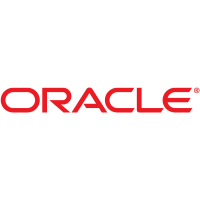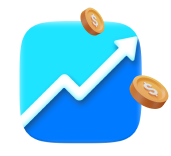
Cancel anytime
- Chart
- Upturn Summary
- Highlights
- Revenue
- Valuation
- Analyst Ratings
 Upturn AI SWOT
Upturn AI SWOT - About
Oracle Corporation (ORCL)

- BUY Advisory
- SELL Advisory (Profit)
- SELL Advisory (Loss)
- Profit
- Loss
- Pass (Skip investing)

 Stock price based on last close
Stock price based on last close (see disclosures)
- ALL
- YEAR
- MONTH
- WEEK
Upturn Advisory Summary
03/27/2025: ORCL (1-star) is currently NOT-A-BUY. Pass it for now.
Analysis of Past Performance
Type Stock | Historic Profit 15.63% | Avg. Invested days 42 | Today’s Advisory PASS |
Upturn Star Rating   | Upturn Advisory Performance | Stock Returns Performance |
Key Highlights
Company Size Large-Cap Stock | Market Capitalization 414.47B USD | Price to earnings Ratio 34.71 | 1Y Target Price 186.16 |
Price to earnings Ratio 34.71 | 1Y Target Price 186.16 | ||
Volume (30-day avg) 10965075 | Beta 1.07 | 52 Weeks Range 111.92 - 197.80 | Updated Date 03/27/2025 |
52 Weeks Range 111.92 - 197.80 | Updated Date 03/27/2025 | ||
Dividends yield (FY) 1.35% | Basic EPS (TTM) 4.2 |
Analyzing Revenue: Products, Geography and Growth
Revenue by Products
Product revenue - Year on Year
Revenue by Geography
Geography revenue - Year on Year
Earnings Date
Report Date 2025-03-10 | When Before Market | Estimate 1.4894 | Actual 1.47 |
Profitability
Profit Margin 21.8% | Operating Margin (TTM) 31.3% |
Management Effectiveness
Return on Assets (TTM) 7.35% | Return on Equity (TTM) 103.74% |
Valuation
Trailing PE 34.71 | Forward PE 21.01 | Enterprise Value 487254232520 | Price to Sales(TTM) 7.43 |
Enterprise Value 487254232520 | Price to Sales(TTM) 7.43 | ||
Enterprise Value to Revenue 8.73 | Enterprise Value to EBITDA 20.91 | Shares Outstanding 2804229888 | Shares Floating 1650235624 |
Shares Outstanding 2804229888 | Shares Floating 1650235624 | ||
Percent Insiders 41.11 | Percent Institutions 44.89 |
Analyst Ratings
Rating 4.06 | Target Price 196.55 | Buy 5 | Strong Buy 16 |
Buy 5 | Strong Buy 16 | ||
Hold 14 | Sell - | Strong Sell - | |
Strong Sell - |
 Upturn AI SWOT
Upturn AI SWOT
Oracle Corporation

Company Overview
History and Background
Oracle Corporation was founded in 1977 by Larry Ellison, Bob Miner, and Ed Oates. Initially named Software Development Laboratories (SDL), it later became Oracle Systems Corporation and finally Oracle Corporation. A significant milestone was the release of Oracle's first database in 1979. Over time, Oracle expanded from database software into cloud computing, enterprise resource planning (ERP), and other enterprise solutions.
Core Business Areas
- Cloud and License: Offers cloud services and license support, including Infrastructure-as-a-Service (IaaS), Platform-as-a-Service (PaaS), and Software-as-a-Service (SaaS) solutions. Also includes traditional on-premise software licenses and related support services.
- Hardware: Provides hardware products, including servers, storage, and networking equipment optimized for Oracle software.
- Services: Offers consulting, advanced support and education services to assist customers with deploying and managing Oracle technologies
Leadership and Structure
Safra A. Catz serves as the Chief Executive Officer. Larry Ellison is the Chairman of the Board and Chief Technology Officer. Oracle has a hierarchical structure with various divisions responsible for different product lines and regions.
Top Products and Market Share
Key Offerings
- Competitors: Microsoft SQL Server, IBM Db2, AWS, Google Cloud, SAP
- Oracle Database: A leading relational database management system (RDBMS) used by organizations worldwide. Oracle holds a substantial market share in the database market, estimated around 40% (including cloud databases). Competitors include Microsoft SQL Server, IBM Db2, and open-source databases like MySQL and PostgreSQL. Revenue generated by database related license and support are a substantial part of Oracle's overall revenue, however, a specific revenue number is difficult to directly isolate.
- Competitors: AWS (Amazon Web Services), Microsoft Azure, Google Cloud Platform (GCP), IBM Cloud.
- Oracle Cloud Infrastructure (OCI): A suite of cloud computing services, including compute, storage, networking, and databases. OCI is a competitor to AWS, Azure, and Google Cloud. OCI is growing rapidly, though it lags behind the market leaders in market share. As of 2023, Oracleu2019s Cloud market share is approximately 2-3% globally.
- Competitors: SAP Business One, Microsoft Dynamics 365, Sage Intacct, Infor.
- Oracle NetSuite: A cloud-based ERP suite for small to medium-sized businesses. Competitors include SAP Business One and Microsoft Dynamics 365. NetSuite has a growing presence in the SMB ERP market, competing with established vendors
- Competitors: Open source technologies: Python, Javascript, C#.
- Java: Java is a cross-platform, object-oriented programming language. The majority of Java's revenue is generated from the Cloud and License, hardware and services, however, a specific revenue number is difficult to directly isolate.
Market Dynamics
Industry Overview
The IT industry is driven by technological advancements, digital transformation, and increasing demand for cloud services, data analytics, and cybersecurity solutions. The industry is highly competitive and experiences rapid innovation.
Positioning
Oracle Corporation is positioned as a leading provider of enterprise software and cloud solutions. Its competitive advantages include its extensive product portfolio, strong brand recognition, and large customer base. Oracle is focusing on growing its cloud business to compete effectively with AWS, Azure, and Google Cloud.
Total Addressable Market (TAM)
The total addressable market for enterprise software and cloud computing is estimated to be several hundred billion dollars. Oracle is positioned to capture a significant portion of this market by leveraging its existing customer base and expanding its cloud offerings.
Upturn SWOT Analysis
Strengths
- Extensive Product Portfolio
- Strong Brand Recognition
- Large Customer Base
- Leading Database Technology
- Significant Investments in Cloud Infrastructure
Weaknesses
- Complex Product Licensing
- Slower Adoption of Cloud
- High Cost of Ownership
- Perception of Being Less Innovative than Competitors
Opportunities
- Growing Demand for Cloud Services
- Expansion into Emerging Markets
- Adoption of AI and Machine Learning
- Strategic Acquisitions
- Hybrid cloud solutions
Threats
- Intense Competition from Cloud Providers
- Open-Source Alternatives
- Economic Downturn
- Cybersecurity Threats
- Changing Regulatory Landscape
Competitors and Market Share
Key Competitors
- MSFT
- AMZN
- SAP
Competitive Landscape
Oracle faces intense competition from cloud providers, open-source databases, and other enterprise software vendors. Oracleu2019s advantages include its large customer base and extensive product portfolio. Disadvantages include its complex licensing and slower adoption of cloud.
Major Acquisitions
Cerner
- Year: 2022
- Acquisition Price (USD millions): 28300
- Strategic Rationale: Expanded Oracleu2019s presence in the healthcare industry and provided access to Cerneru2019s electronic health record (EHR) system.
Growth Trajectory and Initiatives
Historical Growth: Oracle Corporation has grown over the past years through organic growth and acquisitions.
Future Projections: Analyst estimates project continued growth for Oracle Corporation, driven by its cloud business and strategic initiatives.
Recent Initiatives: Recent strategic initiatives undertaken by Oracle Corporation include investments in cloud infrastructure, acquisitions of complementary businesses, and partnerships with other technology companies.
Summary
Oracle is a well-established technology company with a strong presence in the enterprise software and cloud markets. The company's database technology remains a key strength, and its cloud business is experiencing rapid growth. However, Oracle faces intense competition and needs to continue innovating to maintain its market position. Its acquisition of Cerner seems promising, but it still needs to iron out the creases in the integration and ensure healthcare is the right fit. Overall, Oracle is a fundamentally sound business that must adapt to cloud computing's ever-changing landscape.
Similar Companies
- MSFT
- SAP
- CRM
- IBM
- ACN
Sources and Disclaimers
Data Sources:
- Oracle Corporation Investor Relations
- Industry Analyst Reports
- Financial News Articles
- SEC Filings (10K and 10Q)
Disclaimers:
The information provided is for informational purposes only and does not constitute financial advice. Market share data is approximate and may vary depending on the source. Financial data is subject to change. It is always important to do your own research.

![]() AI Summarization is directionally correct and might not be accurate.
AI Summarization is directionally correct and might not be accurate.

![]() Summarized information shown could be a few years old and not current.
Summarized information shown could be a few years old and not current.

![]() Fundamental Rating based on AI could be based on old data.
Fundamental Rating based on AI could be based on old data.

![]() AI-generated summaries may have inaccuracies (hallucinations). Please verify the information before taking action.
AI-generated summaries may have inaccuracies (hallucinations). Please verify the information before taking action.
About Oracle Corporation
Exchange NYSE | Headquaters Austin, TX, United States | ||
IPO Launch date 1986-03-12 | CEO & Director Ms. Safra Ada Catz | ||
Sector Technology | Industry Software - Infrastructure | Full time employees 159000 | Website https://www.oracle.com |
Full time employees 159000 | Website https://www.oracle.com | ||
Oracle Corporation offers products and services that address enterprise information technology environments worldwide. Its Oracle cloud software as a service offering include various cloud software applications, including Oracle Fusion cloud enterprise resource planning (ERP), Oracle Fusion cloud enterprise performance management, Oracle Fusion cloud supply chain and manufacturing management, Oracle Fusion cloud human capital management, Oracle Cerner healthcare, and NetSuite applications suite, as well as Oracle Fusion Sales, Service, and Marketing. The company also offers cloud-based industry solutions for various industries; Oracle application licenses; and Oracle license support services. In addition, it provides cloud and license business' infrastructure technologies, such as the Oracle Database and MySQL Database; Java, a software development language; and middleware, including development tools and others. The company's cloud and license business' infrastructure technologies also comprise cloud-based compute, storage, and networking capabilities; and Oracle autonomous database and MySQL HeatWave, as well as Internet-of-Things, digital assistant, and blockchain. Further, it provides hardware products and other hardware-related software offerings, including Oracle engineered systems, enterprise servers, storage solutions, industry-specific hardware, virtualization software, operating systems, management software, and related hardware services, as well as hardware support products; and consulting and customer services. The company markets and sells its cloud, license, hardware, support, and services offerings directly to businesses in various industries, government agencies, and educational institutions, as well as through indirect channels. Oracle Corporation was founded in 1977 and is headquartered in Austin, Texas.
Note: This website is maintained by Upturn Corporation, which is an investment adviser registered with the U.S. Securities and Exchange Commission. Such registration does not imply a certain level of skill or training. Investing in securities has risks. Past performance is no guarantee of future returns. No assurance is provided as to any particular investment return, and you may lose money using our services. You are strongly advised to consult appropriate counsel before making any investments in companies you learn about through our services. You should obtain appropriate legal, tax, investment, accounting, and other advice that takes into account your investment portfolio and overall financial situation. You are solely responsible for conducting due diligence on a potential investment. We do not affect trades for you. You will select your own broker through which to transact. Investments are not FDIC insured, they are not guaranteed, and they may lose value. Please see the Privacy Policy, Terms of Use, and Disclosure for more information.


 Home
Home 

